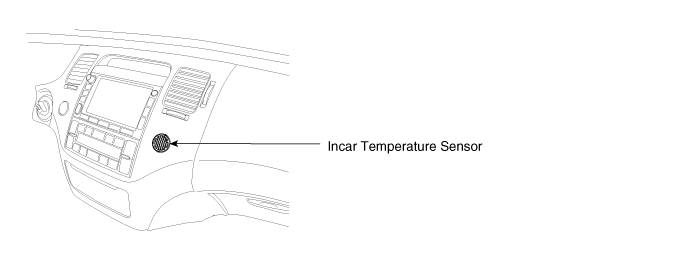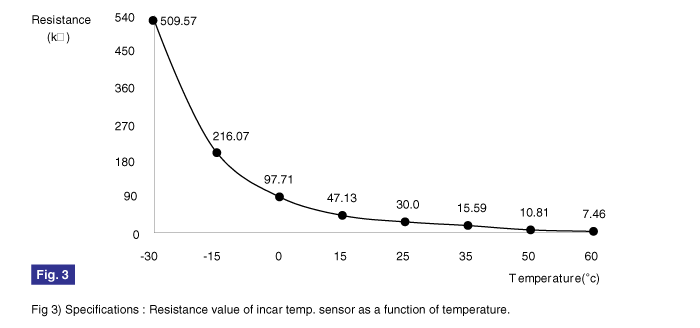Monitor the "INCAR TEMP. SENSOR" Parameter on the Scantool.


The incar temperature sensor located at crush pad, control unit contains a thermistor which measures the temperature of the inside. The signal, decided by the resistance value which changes in accordance with perceived inside temperature, is delivered to heater control unit and according to this signal, the control unit regulates incar temperature to intended value.
The A/C controller sets DTC B1234 if there is an open circuit in incar temp. sensor signal harness or the measured resistance value of sensor is more than threshold value(about 509.57kΩ)
Item | Detecting Condition | Possible cause |
DTC Strategy | ● Resistance check | ● Open Circuit in harness ● Faulty incar temp. Sensor ● Faulty A/C control unit |
Threshold value | ● > 509.57 kΩ | |
Detecting time | ● 0.3 sec | |
FAIL SAFE | ● Control with the value of 25°C(77°F) |
Temperature[°C(°F)] | Resistance(kΩ) | Temperature[°C(°F)] | Resistance(kΩ) |
-30(-22) | 509.57 | 25(77) | 30 |
-15(5) | 216.07 | 35(95) | 15.59 |
0(32) | 97.71 | 50(122) | 10.81 |
15(59) | 47.13 | 60(140) | 7.46 |
Connect scantool to data link connector(DLC).
Engine "ON"
Monitor the "INCAR TEMP. SENSOR" Parameter on the Scantool.

Are the DTC B1234 present and is parameter of "INCAR TEMP. SENSOR" fixed?
※ Parameter of "INCAR TEMP. SENSOR" will be fixed at 25℃(77℉), if there is any fault in INCAR TEMP. SENSOR.

Go to "Inspection" procedure.

Fault is intermittent caused by poor contact in the sensor's and/or A/C controller's connector or was repaired and A/C controller memory was not cleared. Thoroughly check connectors for looseness, poor connection, bending, corrosion, contamination, deterioration, or damage. Repair or replace as necessary and then go to "Verification of Vehicle Repair" procedure.
Many malfunctions in the electrical system are caused by poor harness and terminals.
Faults can also be caused by interference from other electrical systems, and mechanical or chemical damage.
Thoroughly check connectors for looseness, poor connection, bending, corrosion, contamination, deterioration, or damage.
Has a problem been found?

Repair as necessary and go to "Verification of Vehicle Repair" procedure.

Go to "Signal circuit inspection" procedure.
Check for open in harness.
Ignition "OFF"
Disconnect incar temp. sensor.
Measure resistance between terminal "4" of incar temp. sensor and terminal "5" of A/C Control Unit..
Specification : Approx. 0 Ω

Is the measured resistance within specifications?

Go to "Ground circuit Inspection " procedure.

Check for open in harness. Repair as necessary and go to "Verification of Vehicle Repair" procedure.
Check for open in ground harness.
Ignition "OFF"
Disconnect incar temp. sensor.
Measure resistance between terminal "2" of incar temp. sensor and terminal "12" of A/C Control Unit.
Specification : Approx. 0 Ω

Is the measured resistance within specifications?

Go to "Component Inspection " procedure.

Check for open in ground harness. Repair as necessary and go to "Verification of Vehicle Repair" procedure.
Check incar temp. sensor.
Ignition "OFF"
Disconnect incar sensor.
Measure resistance between terminal "4" and "2" of incar sensor.
Specification : Refer the specifications in fig 3.


Is the measured resistance within specifications in fig3? (tolerance limits ± 3%)

Go to "Check A/C Control Unit" procedure.

Substitute with a known-good incar sensor and check for proper operation.
If the problem is corrected, replace incar sensor and then go to "Verification of Vehicle Repair" procedure.
Check A/C Control Unit
Engine "ON"
Disconnect incar sensor.
Measure Voltage between terminal "5" of A/C Control Unit and chassis ground.
Specification : Approx. 5V

Is the measured voltage within specifications?

Check connectors for looseness, poor connection, bending, corrosion, contamination, deterioration, or damage. Repair or replace as necessary and then go to "Verification of Vehicle Repair" procedure.

Substitute with a known-good A/C Control Unit and check for proper operation.
If the problem is corrected, replace A/C Control Unit and then go to "Verification of Vehicle Repair" procedure.
After a repair, it is essential to verify that the fault has been corrected.
Connect scantool and select "Diagnostic Trouble Codes(DTCs)" mode and then clear DTC.
Operate the vehicle and monitor the DTC on the scantool.
Are any DTCs present?

Go to the applicable troubleshooting procedure.

System is performing to specification at this time.